
Eurostat raises Eurozone GDP estimates
In the first quarter 2025, +0.6% over the previous quarter and +1.5% over a year ago

In the first quarter of 2025, seasonally adjusted GDP increased by 0.6 percent compared to the previous quarter in both the euro area and the EU. The figure comes from an estimate released today by Eurostat, the statistical office of the European Union. In the fourth quarter of 2024, GDP had grown by 0.3 percent in the euro area and 0.4 percent in the EU.
Compared with the same quarter of the previous year, seasonally adjusted gdp increased by 1.5% in the euro area and 1.6 percent in the EU in the first quarter of 2025, following +1.2% in the euro area and +1.4% in the EU in the previous quarter. Making a comparison, also in the first quarter of 2025, U.S. GDP decreased by 0.1% from the previous quarter (after +0.6 percent in the fourth quarter of 2024). Compared with the same quarter a year earlier, U.S. gdp increased by 2.1% (after +2.5 percent in the previous quarter).
In the EU, Ireland (+9.7%) recorded the highest increase in gdp over the previous quarter, followed by Malta (+2.1%) and Cyprus (+1.3 %). The largest declines were observed in Luxembourg (-1%), Slovenia (-0.8%), Denmark and Portugal (both -0.5%).
In the first quarter of 2025, the components of GDP evolved as follows:
- household final consumption expenditure increased by 0.2 percent in both the euro area and the EU (after +0.5 percent in the euro area and +0.6 percent in the EU in the previous quarter),
- general government final consumption expenditure remained stable in the euro area and decreased by 0.1 percent in the EU (after +0.4 percent and +0.5 percent respectively in the previous quarter),
- gross fixed capital formation increased by 1.8 percent in both the euro area and the EU (after +0.7 percent and +0.6 percent respectively),
- exports increased 1.9% in the euro area and 1.6% in the EU (after +0.0% and +0.1% respectively),
- imports increased by 1.4 percent in both the euro area and the EU (after -0.1 percent in both areas).
The contribution to GDP growth by:
- household final consumption expenditure was positive for both the euro area and the EU (+0.1 percent in both),
- general government final expenditure was negligible for both the euro area and the EU,
- gross fixed capital formation was positive for both the euro area and the EU (+0.4 percent),
- the change in inventories was negative for both the euro area and the EU (-0.1%),
- exports minus imports were positive for both the euro area (+0.3%) and the EU (+0.2%).
Regarding employment, in the first quarter of 2025, the number of employed people increased by 0.2% in the euro area and remained stable in the EU, compared to the previous quarter. In the fourth quarter of 2024, employment had increased by 0.1% in the euro area and 0.2% in the EU. Compared with the same quarter a year earlier, employment increased by 0.7% in the euro area and 0.4% in the EU in the first quarter of 2025, following +0.8% in the euro area and +0.6% in the EU in the fourth quarter of 2024.
Hours worked decreased by 0.3% in both the euro area and the EU in the first quarter of 2025, compared with the previous quarter. Compared with the same quarter a year earlier, hours worked increased by 0.1% in the euro area and decreased by 0.2% in the EU.
The combination of GDP and employment data allows estimating labor productivity.In the first quarter of 2025, person-based productivity increased by 0.8% in the euro area and 1.3% in the EU compared to the same quarter a year earlier. Based on hours worked, productivity compared to the same quarter of the previous year increased by 1.1% in the euro area and 1.7% in the EU.
EFA News - European Food Agency